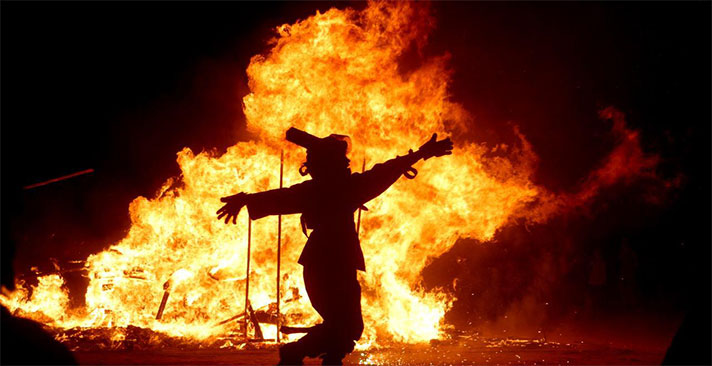The significance of the 2021 Iranian festivity before Nowruz
by Hassan Mahmoudi
A Voice says, “We will celebrate the fire festival to the dismay of Khamenei. Death to Khamenei and the Islamic Republic”.
On March 16, 2021, Iranians celebrated the ancient festival of Chaharshanbe Soori or fire festival which has its origin in ancient Iranian rituals, on the eve of the last Wednesday before Nowruz (the first day of New year in the Iranian calendars).
Before the start of the festival, people gather brushwood in an open, free exterior space. At sunset, after making one or more bonfires, they jump over the flames while singing.
The regime hates Chaharshanbe Soori festival and views it as a threat to its security. Iranians celebrate regardless of the regime’s threats against the celebration of the Fire Festival.
On Tuesday, Mar. 16, Despite broad efforts by the regime to prevent celebrations people across Iran, celebrated this Persian tradition.
The regime fears that such assemblies can lead up to anti-regime protests. Therefore the security forces prepared intense measures to prevent any kind of celebration.
According to reports obtained from different cities, there was a heavy presence of security forces in different cities. In Karaj, Alborz province, security forces were patrolling the streets to prevent people from congregating.
In Tehran, the people celebrated the Fire Festival in the Gomrok and Abbasi Squares by lighting firecrackers. In Javadieh, the people lit firecrackers despite the presence of security forces.
In Varamin, Southeast of Tehran province, the youth threw firecrackers at the wall of a base of security forces in defiance of the regime’s efforts to prevent celebrations. “Varamin’s flag is always up”, one youth said as he threw a firecracker at the headquarters of security forces.
In Karaj, near Tehran, Iran. The voice of firecrackers and bonfires tonight were heard till midnight. In a clip on social media, a Voice says, “We will celebrate the fire festival to the dismay of Khamenei. Death to Khamenei and the Islamic Republic.”
The state-run Tasnim News Agency quoted the commander of State Security Forces in Tehran Hossein Rahimi as saying that there have been at least 25 explosion incidents on the night of Fire Festivals despite the heavy repressive measures held by the regime to prevent assemblies and festivities. “The situation this year is not good in comparison to last year”, Rahimi said.
The official IRNA news agency also reported that in Kerman, Fire Festival ceremonies were more intense than in past years.
In Sanandaj (west of Iran), the regime has dispatched motorcades of security forces to prevent celebrations. Security forces are also controlling entrances and exits to the city.
In Ardebil, (NW Iran) the people chanted “No to the Islamic Republic”, the sky lantern says. Iranians are taking advantage of the Fire Festival to express their resentment towards the regime.
In the fire festival, the Iranian burned a turban, worn by the mullahs, to show their resentment towards Iran’s ruling clerics that has brought them nothing but 42 Years Of Misery.
According to the state-run Tasnim News Agency, Manuchehr Nasiri, the deputy commander of the State Security Forces in Yazd province, threatened the people and said, “Vehicles and persons who disrupt social norms and comfort will be arrested and held by the police until 15 days after the New Year”.
Nasiri said that State Security Forces are on high alert across the province and are monitoring activities on the streets and on social media.
Social media exploded with clips of fire festival showing that the locals in Zahedan (Balochistan center) and in Rasht (Northwest of Iran) torched Khamenei effigies. Fire Festival celebrations continued through the night.
Reports and videos obtained from different cities in Iran pertain that festivities continued despite the heavy presence of security forces. In Kermanshah (west of Iran), the people lit fires in Nastaran Blvd and Markazi Sq and celebrated the Fire Festival.
In Urmia (west of Iran), people lit fireworks and firecrackers across the city. In Eslamshahr (south of Tehran), the sounds of firecrackers could be heard in different parts of the city. In Baneh (west of Iran), the people lit firecrackers in the streets. In Rasht (Northwest of Iran) a large crowd gathered and celebrated the Fire Festival with firecrackers and bonfires.
To end this, the significance of this year’s fire festival compared to the last year is that the people were more organized and more resilient against despotism. The Resistance Units had an important role in leading and organizing the people and slogans such as, “down with the dictator, hail to freedom”, “The supreme leader’s end is near”, “We will take back Iran”, and “We will turn Iran into a burning cry for freedom”.
Hassan Mahmoudi is a Europe-based social analyst, researcher, independent observer, and commentator of Middle Eastern and Iranian Politics. He tweets under @hassan_mahmou1.



